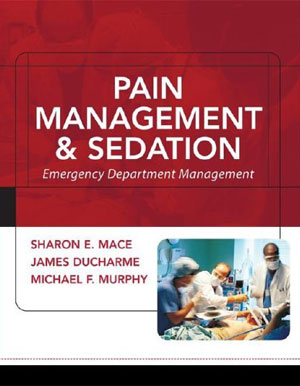The Only Reference on Managing Pain in the Emergency Room! This
groundbreaking resource will be the first book ever written that
provides an authoritative, clinical reference on managing acute pain
and chronic pain problems in the Emergency Room.
About the Author
- Sharon E. Mace, MD, Director, Observation Unit, and Director,
Pediatric Education, Department of Emergency Medicine, The Cleveland
Clinic, Cleveland, Ohio
Dr. Mace and her colleagues at Cleveland Clinic are the recipients of
several NIH grants to study pain management in the ED; this is an
outgrowth of their work in chest pain/cardiovascular disease in the
ED.
- James B. Ducharme, MD, Professor of Emergency Medicine, Dalhousie
University, New Brunswick, Canada As one of the “gurus” of pain
management in the ED, Dr. Ducharme is a frequent lecturer in the US
and Canada. Dr. Ducharme has organized the pain management sessions
at the ACEP National Scientific Assembly the last 2 years.
_ Michael Murphy, MD, Chief of Anesthesiology, Lincolnton Medical
Center, Lincolnton, North Carolina and Clinical Assistant Professor
of Emergency Medicine, University of North Carolina, Chapel Hill,
North Carolina Dr. Murphy is double-boarded in Anesthesiology and
Emergency Medicine and a co-editor of Ron Walls’ successful Airway
Management book for Lippincott.
Section I: ADMINISTRATIVE
1. History/Background
2. Definitions
3. Regulations
4. Documentation/Standardized Forms
5. Quality Improvement/Risk Management
6. Legal Aspects
7. Policies and Procedures
Section II: APPROACH TO THE PATIENT
1. Preprocedural Patient Assessment
2. American Society of Anesthesia (ASA) Classifications
3. Pain Scales
4. Equipment
5. Procedural Patient Assessment and Monitoring
a. Airway
b. Respiratory
c. Cardiovascular/Hemodynamics
d. Neurologic
6. Post Procedure Evaluation
a. Discharge Criteria Assessment of Patient Stability
b. Patient Discharge Instructions
Section III: PHYSIOLOGY
1. Cardiovascular
2. Respiratory
3. Central Nervous System
4. Autonomic Nervous System
5. Renal
6. Hepatic
Section IV: PROCEDURE/TECHNIQUES
1. Conscious Sedation
2. Pain Management
a. Definition, acute vs chronic
b. Pathophysiology
c. The Drug Seeking Patient
3. Regional Anesthesia
4. Nerve Blocks
5. Local Anesthesia
a. Topicals
1. Vapocoolant sprays
2. Creams: EMLA, Eutetic, elemax
3. Combination Solutions: Tac, LET
b. Injectables
1. Amides
2. Esters
3. Long acting vs short acting
4. Others: Benadryl
c. Iontophoresis (numby)
Section V. PHARMACOLOGY
1. Muscle Relaxants
2. Neuromuscular Blockers
3. Adjunctive Medications
a. Atropine/Glycopyrolate
b. Lidocaine
c. Others
4. Reversal Agents
a. Naloxone/Naltrexone
b. Flumazenil
5. Agents for Conscious Sedation (Sedative Drugs)
a. Propofol
b. Etomide
c. DPT
d. Chloral Hydrate
e. Barbiturates
f. Benzodiazepines
g. Ketamine
6. Pain Medications
a. Opoids
b. Nonsteroidal
c. Acetaminophen
d. Others
7. Anesthetics
a. Inhalant anesthetics
b. Nitrous oxide
Section VI: SPECIAL CONSIDERATIONS
1. Devices
a. Transcutaneous Electrical Nerve Stimulation (TENS)
b. Continuous Infusions
2. Palliative Care
3. Pediatrics
a. Pediatrics
b. Neonates
c. Children with Special Health Care Needs
4. Geriatrics
5. The Pregnant Patient
6. Nonpharmacologic Interventions
a. Hypnosis
b. Psychologic Techniques


